 FluteTree :
History and Nature :
FluteTree :
History and Nature :
The renaissance of the Native American flute has centered on the large plains flute. In academic journals, this style of instrument is described in a number of ways: “duct flute”, “vertical whistle flute with external block”, and “block flute”. Although these flutes came in many shapes and sizes, the use of an external block (or a wide leather strap) for making the whistle is the distinguishing feature with these flutes.

Inside these instruments are two air chambers. The chamber on the right-hand side is the sound chamber, it is important in the pitch of the instrument. A shorter sound chamber produces a higher pitch flute. The purpose of open finger holes is to shorten the effective length of the sound chamber. Closing the finger holes in the right order will lengthen the effective length of the sound chamber. In other words, lowering the flute's pitch. If there were no finger holes, these instruments would be classified as a whistle.

Between these two chambers is the whistle mechanism, which the external block hides most of its detail.
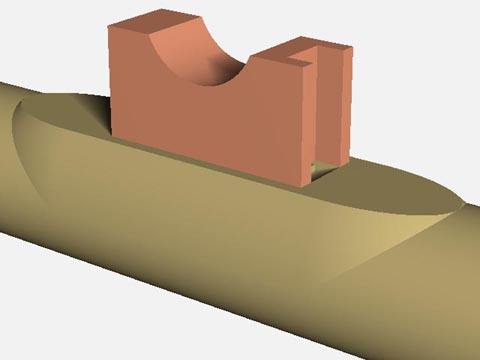
Once the block is removed, you see two holes and a shallow channel connecting them.
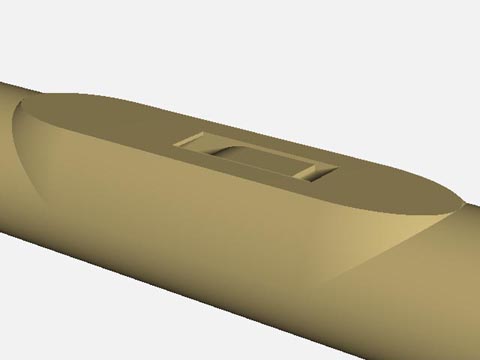
From inside, you can see the two holes and channel connect the two air chambers.
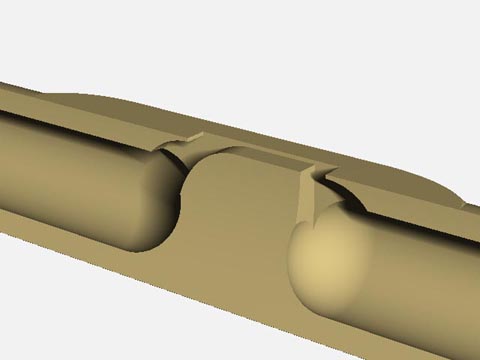
Basically as you blow the flute, air flows into the first air chamber and up into the shallow channel. A block strapped on top of the flute, provides a seal over the first hole and channel.
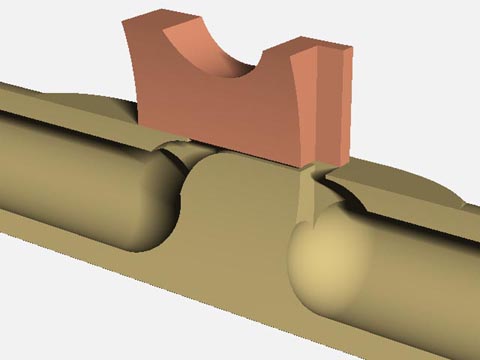
The shallow channel smoothes the air flow and creates a narrow stream of air across the second hole, which is also called the tone hole. Once the air leaves the narrow slit of the channel, it becomes turbulent again. Actually, it waves up and down like a flag that wave back and forth in the wind. This motion of provides the energy that causes the second air chamber to resonate.
An alternative to carving the shallow channel is to use a metal spacer with a slot cut out of it. These were common in the early plains flutes. By sliding the spacer back and forth, one could adjust the sound of the flute.
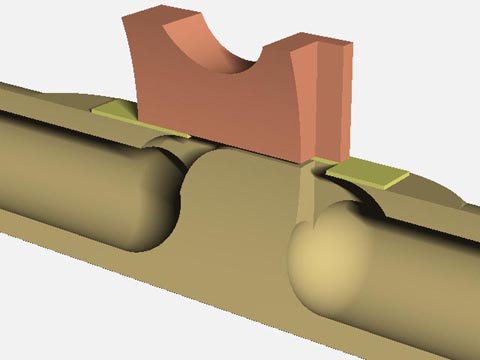
Another approach was to carve or grind (file) the channel at an angle, which is a lot easier than carving a level channel, and strap on a small strip of metal that acts as the cutting edge of the tone hole. Again the adjustable cutting edge allowed the sound of the flute to be tweaked.
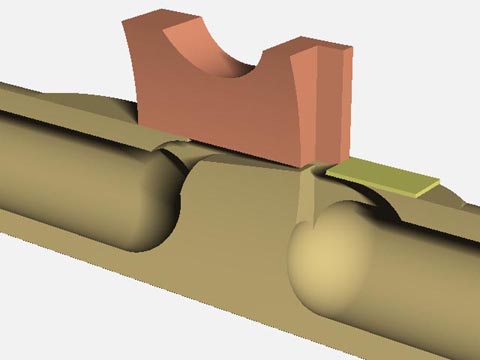
This design resembles those of wooden pipe in old organs, which has made some wonder if there were some western influences in the making of these instruments. In 1832, George Catlin wrote in a letter about the plains flute while visiting the mouth of the Teton River, Upper Missouri:
" There is yet another wind instrument which I have added to my Collection and from its appearance would seem to have been borrowed, in part, from the civilized world. This is what is often on the frontier called a 'deer-skin flute', a Winnebago courting flute, 'tsal-eet-quash-to'; it is perforated with holes for the fingers, sometimes for six, at others for four, and in some instances for three only, having only so many notes with their octaves. These notes are very irregularly graduated, ... "
The most detailed historic account of flute construction, comes from Rev. Alfred Longley Riggs, a missionary, friend, and educator to the Santee Sioux people, who writes in 1869:
" The pipe or flute is called cho-tan-ka, which
means literally, 'big-pith.' It has two varieties, one made of wood, and the other of bone.
The first is the most common, and much resembles the flageolet. It is made by taking the
sumac--a wood which has the requisite "big-pith"--a straight piece nineteen or twenty inches
long, and, when barked and smoothed down, an inch and a quarter in diameter. This is split
open in the middle, and the pith and inner wood carefully hollowed out to make a bore of five
eighths of an inch diameter, extending through the whole length, except that it grows smaller
at the mouth-piece, and at a point four inches below that, it is interrupted entirely by a
partition three eighths of an inch thick, which is left to form the whistle. The halves are
glued together. Finger-holes one quarter of an inch in diameter, and usually six in number,
are burnt along the upper face. On the same face the whistle is made by cutting a hole three
eights of an inch square each side of the partition. Then, over these, and connecting them, is
laid a thin plate of lead, with a slit cut in it, a little more than an inch long and three
eights of an inch wide. On top of this is a block of wood, two inches long and three fourths
of an inch wide, flat on the bottom, and carved above into rough likeness of a horse; and a
deer-skin string binds the whole down tight. A brass thimble for a mouth-piece, some ribbon
streamers, a few lines of carving, and a little red and yellow paint, and the instrument is
complete.
The pitch of the particular pipe to which this description mainly refers, seems to have been
originally A prime, and changed to G prime by boring a seventh hole. One formerly in my
possession was pitched at E flat prime; and from it the airs which are here give were taken
down.
The second variety of the cho-tan-ka is made of the long bone of the wing or thigh of the swan
and crane. To distinguish the first from the second, they call the first the murmuring
(literally 'bubbling') cho-tan-ka, from the tremulous note it gives when blown with all the
holes stopped."
This 'bubbling' flute reference is one of the earliest descriptions of the warble, which is sound that appears to be highly prized in earlier times. Such flutes, could be blown forcefully with all holes covered while the pitch of the flute would repeatedly jump an octave and then immediately fall an octave. When first heard, many mistake the warble for a strong vibrato, which it is not. But the warble is a whole other topic, which is covered in another essay.
There is much creativity in flute making, especially in the historic flutes. Five and six hole flutes seemed to be the most common. Some flutes had even more. Additional holes are commonly found close to the end of the flutes. These are tuning holes, that allow a longer flute to sound like a shorter flute, like the top two flutes in the following illustration. It was common practice to have four tuning holes, also called the four direction holes. Some makers would use slits instead of holes. The extra length in the flute could be used for all sorts of decorations, bird heads appeared to be a favorite.
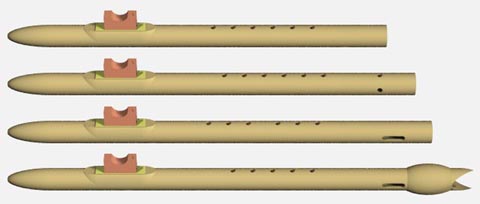
The blocks came in many shapes sizes and styles. Many were carved as animals, such as birds and horses. Many of these choices in entire flute were of symbolic importance. Even the choice of materials was varied. Effectively, anything that could be converted or made into a long hollow barrel, such as straight splitting cedar or old gun barrels. This style of flute also appears to be recent invention from the 1800s. Whether it is a natural evolution of the cane flute or influenced by the instruments of outside explorers, we cannot ignore the artistry of the makers.


